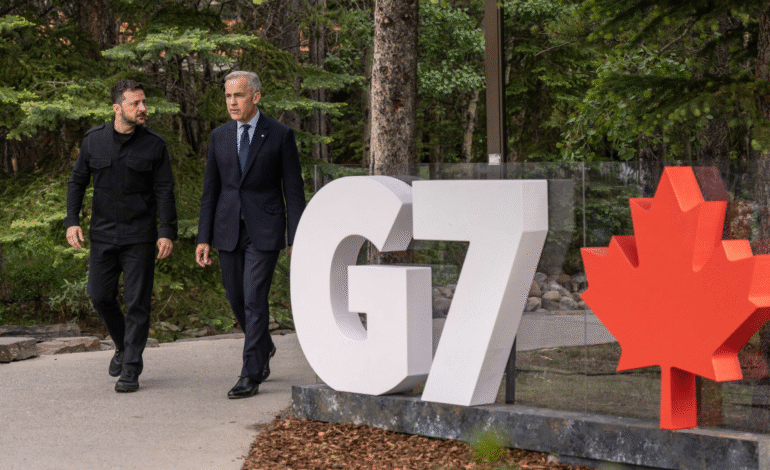NATO and G7 Support Ukraine’s Strategic ‘Defence City’ Initiative

Ukraine’s Defence City initiative is gathering strong international backing as global powers most notably NATO and G7 representatives signal full support for the bold and far-reaching defense-industrial reforms set to transform Ukraine’s military capabilities. With its eyes set on becoming a global defense production hub, Ukraine is not only inviting foreign investment but also granting unprecedented tax and customs privileges to defense companies under a new legal regime. The effort represents a massive shift in the structure of wartime economics and post-war readiness and one that Middle Eastern policymakers and investors are watching closely.
Ukraine’s Ambitious Plan: Birth of the Defence City Model
The Defence City concept is a flagship project spearheaded by Ukraine’s Ministry of Defence, specifically the Procurement Department led by Hleb Kanevsky. It introduces a special legal regime designed to accelerate the country’s defense manufacturing capacity. The strategy focuses on creating both domestic defense manufacturing zones and spare production sites in partner countries under the Ramstein platform an international coalition of nations that have supported Ukraine militarily and financially since Russia’s full-scale invasion in 2022.
This legal regime is intended to nurture domestic and international defense enterprises by removing bureaucratic friction, providing significant tax relief, and facilitating smooth import-export processes through streamlined customs reforms. The Ukrainian government plans to establish a network of these “Defence City” zones, where companies can operate under favorable investment conditions while fulfilling the pressing need for advanced military equipment, including weapons, ammunition, drones, and missile systems.
NATO and G7 Countries Endorse the Vision
What makes this initiative globally significant is the endorsement it has received from NATO and G7 representatives. These international actors are not only aligned with Ukraine’s vision but are reportedly prepared to assist in implementing the Defence City framework, both inside Ukraine and across select allied territories. According to recent reports, there have been high-level meetings between Ukraine’s legislative leaders and foreign defense officials who have expressed willingness to support and co-finance defense companies that will be situated in their own countries under the broader Defence City umbrella.
This support comes at a critical juncture. As the conflict in Ukraine drags on, Western countries are increasingly looking for sustainable long-term solutions rather than short-term weapons shipments. The creation of shared defense production infrastructure offers a more resilient, cooperative model. G7 support also signifies broader confidence in Ukraine’s economic recovery path, particularly in sectors like defense that will play a pivotal role in reconstruction and national security.
Legislative Action Underway: Parliament to Pass Initial Bills
To legally implement the Defence City model, Ukraine has introduced two landmark legislative proposals—Bill No. 13420 and Bill No. 13421. These bills aim to amend the Tax Code and the Customs Code of Ukraine, respectively, to align with the requirements of the Defence City concept.
David Arakhamia, head of the ruling Servant of the People parliamentary faction, confirmed that both bills will undergo their first reading in parliament within the week. He also indicated that the complete legislative package is expected to be signed into law by Ukraine’s Independence Day, marked on August 24.
The Finance Committee of the Ukrainian Parliament has already approved the bills for their first reading. Once passed, these laws will provide the structural backbone for the Defence City concept, ensuring legal protection for registered defense enterprises and incentivizing both domestic and foreign investment.
Fiscal Benefits: Unprecedented Incentives Until 2036
At the core of the Defence City model is a powerful array of financial incentives meant to draw both local and international firms. The proposed bills provide tax exemptions that will remain effective until January 1, 2036. These include:
Full exemption from income tax, provided profits are reinvested into defense production
- Exemption from land tax, environmental tax, and real estate tax
- Accelerated depreciation schemes for capital investments
- VAT benefits on imported materials and equipment used for defense manufacturing
- Special provisions for relocated defense companies and their employees
These sweeping reforms make the Defence City zones among the most attractive industrial territories in Eastern Europe for defense-sector investors. With a long-term horizon until 2036, the initiative also gives companies the confidence and stability required for large-scale industrial development.
Ramstein Platform and the International Dimension
Ukraine’s Defence City initiative is not confined to its national territory. The concept also includes the establishment of “spare production sites” in countries that are part of the Ramstein platform a coalition of over 50 countries that coordinate military assistance to Ukraine.
By extending production beyond Ukrainian borders, the Ministry of Defence seeks to insulate its supply chains from disruptions caused by wartime attacks. These external hubs will function as safe, Western-backed satellite production centers, where Ukrainian defense firms can partner with international companies and use Western technology to accelerate output.
This element of the initiative reflects a pragmatic understanding of wartime logistics. It also presents a compelling opportunity for countries in the Middle East, including the UAE and Saudi Arabia, who may be looking to co-produce advanced defense systems or acquire defense capabilities rooted in real battlefield experience.
Ukraine’s Global Ambitions: A New Defense Exporter Emerges
In recent statements, Ukrainian officials have emphasized that the Defence City model is not just about meeting wartime needs it’s also about turning Ukraine into a top-tier defense exporter. Drawing from battlefield-tested technologies and an agile domestic production base, the country aims to join the ranks of the top five global arms exporters by 2030.
This ambition is not far-fetched. Ukraine has already demonstrated excellence in drone warfare, unmanned ground vehicles, and decentralized military innovation. With Western funding and legislative support, Ukrainian defense products could soon be deployed not only within the country but across Europe, Asia, and the Middle East.
This opens new avenues for trade and cooperation between Ukraine and regional powers like the UAE, which have been rapidly expanding their defense industries and investing in advanced military technologies.
Strategic Importance for the Middle East and UAE
From a Middle Eastern perspective, Ukraine’s Defence City offers both strategic and commercial appeal. Countries like the UAE already major players in global defense markets could collaborate with Ukrainian companies to co-develop, license, or even host spare production facilities within their borders.
Moreover, Ukrainian innovation, especially in the fields of UAVs and field-adapted armaments, is seen as battlefield-proven a significant criterion for Middle Eastern buyers. With conflicts in the region necessitating resilient and advanced defense systems, Ukraine’s new industrial base may offer appealing alternatives to traditional Western suppliers.
Additionally, Gulf countries may look at Ukraine’s model as a legislative case study. Its integration of tax exemptions, legal shields for defense companies, and partnership mechanisms could inform defense industry reforms in the Middle East.
Calls for Allied Support: Ukraine Seeks 0.25% of Allied GDP
In tandem with the Defence City initiative, Ukraine has urged its allies to commit 0.25% of their GDP annually toward boosting Ukraine’s defense industry. This request, made at recent high-level meetings, underscores the scale of Ukraine’s ambition and the international funding required to realize it.
It also aligns with NATO’s own push for increased defense spending among its member states. As Ukraine moves toward EU and NATO integration, its defense industry may serve as a bridge for deeper defense cooperation—blurring the lines between domestic production and alliance-wide capability sharing.
This funding ask could also set a precedent for shared defense spending models globally, potentially influencing how Middle Eastern defense alliances like the GCC coordinate future investments.
The Road Ahead: A New Economic Engine for Post-War Ukraine
Ukraine’s Defence City model stands at the intersection of national security, foreign policy, and economic recovery. While its primary goal is to serve the country’s immediate defense needs, it also lays the foundation for a post-war economic revival based on innovation, manufacturing, and global collaboration.
The coming months will be crucial. The passage of Bills 13420 and 13421 will provide the legal muscle. Ramstein countries are expected to start hosting production sites. Investors, including those in the Middle East, are watching closely to assess their entry points into what may become Europe’s fastest-growing defense sector.
As global support solidifies and the Ukrainian parliament moves swiftly to adopt these laws, Defence City may soon become not just a vision but a reality with ripple effects across continents.








1 Comment
[…] moment. The country has been strengthening its defence sector to meet the modernization goals of NATO. Through 4iG S&D, Hungary is expanding beyond information technology and telecommunications […]
Comments are closed.